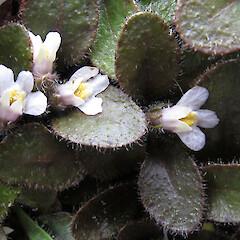Mazus arenarius
Synonyms
None
Family
Mazaceae
Flora category
Vascular – Native
Endemic taxon
Yes
Endemic genus
No
Endemic family
No
Structural class
Herbs - Dicotyledons other than Composites
NVS code
The National Vegetation Survey (NVS) Databank is a physical archive and electronic databank containing records of over 94,000 vegetation survey plots - including data from over 19,000 permanent plots. NVS maintains a standard set of species code abbreviations that correspond to standard scientific plant names from the Ngä Tipu o Aotearoa - New Zealand Plants database.
MAZARE
Chromosome number
2n = 104
Current conservation status
The conservation status of all known New Zealand vascular plant taxa at the rank of species and below were reassessed in 2017 using the New Zealand Threat Classification System (NZTCS) – more information about this can be found on the NZTCS website. This report includes a statistical summary and brief notes on changes since 2012 and replaces all previous NZTCS lists for vascular plants.
Please note, threat classifications are often suggested by authors when publications fall between NZTCS assessment periods – an interim threat classification status has not been assessed by the NZTCS panel.
- Conservation status of New Zealand indigenous vascular plants, 2017 . 2018. Peter J. de Lange, Jeremy R. Rolfe, John W. Barkla, Shannel P. Courtney, Paul D. Champion, Leon R. Perrie, Sarah M. Beadel, Kerry A. Ford, Ilse Breitwieser, Ines Schönberger, Rowan Hindmarsh-Walls, Peter B. Heenan and Kate Ladley. Department of Conservation. Source: NZTCS and licensed by DOC for reuse under the Creative Commons Attribution 4.0 International licence.
2017 | At Risk – Declining | Qualifiers: DP, RR, Sp
Previous conservation statuses
2012 | At Risk – Naturally Uncommon | Qualifiers: DP, RR
2009 | At Risk – Naturally Uncommon
2004 | Gradual Decline
Distribution
Endemic to coastal Otago, Southland and Stewart Island/Rakiura.
Habitat
In dune fields where it grows in seasonally damp swales (depressions), or on rocky coastal lines within coastal turf developed around seepages. Occasionally found along the margins of slow flowing tidal streams.
Wetland plant indicator status rating
Information derived from the revised national wetland plant list prepared to assist councils in delineating and monitoring wetlands (Clarkson et al., 2021 Manaaki Whenua – Landcare Research Contract Report LC3975 for Hawke’s Bay Regional Council). The national plant list categorises plants by the extent to which they are found in wetlands and not ‘drylands’. The indicator status ratings are OBL (obligate wetland), FACW (facultative wetland), FAC (facultative), FACU (facultative upland), and UPL (obligate upland). If you have suggestions for the Wetland Indicator Status Rating, please contact: [Enable JavaScript to view protected content]
FACW: Facultative Wetland
Usually is a hydrophyte but occasionally found in uplands (non-wetlands).
Detailed description
Mat-forming, creeping, rhizomatous herb forming dense green-brown or purple brown patches. Leaves 10–30–(120) mm, opposite, spathulate, obovate to broad-elliptic purple-brown when exposed, green-brown in shade, upper surface finely hairy. Inflorescences terminal, 2–3–(4) flowered. Corolla 6.5–9 mm long, white, flushed purple in throat, palate yellow; lower lobes 3, these rounded, sometimes square or rectangular, or slightly narrowed toward proximal end, apex often retuse; upper lobes 2, narrow-triangular, apex subacute, sometimes retuse. Fruit (3.5)–4.5–7–(9) × (3.5)–4–5–(6) mm, red-purple. Seed 0.7–0.9 mm.
Similar taxa
Perhaps closest to Mazus radicans from which it differs by the smaller, unmottled leaves, smaller, white, scarcely flushed purple, flowers with the lower corolla lobes rounded, and usually with square or retuse apices, while the upper corolla lobes are subacute. As far as is known neither species occur sympatrically.
Flowering
November–December
Flower colours
Violet/Purple, White
Fruiting
December–July–(December)
Propagation technique
Easy from the division of whole plants and seed but not especially attractive, hard to maintain and unless conditions are right slow growing.
Threats
Threatened by the small, fragmented population sizes, the dynamic nature of the species habitat coupled with land development and competition from naturalised plants. Not a common species known only from 7 sites in the southern South Island and 7 on Stewart Island/Rakiura. Several of these populations are on private land and some populations are very small and are known to be experiencing a slow rate of decline.
Etymology
mazus: Tear (after protuberance on throat of flower)
arenarius: Sand dweller
Where To Buy
Not commercially available.
Attribution
Fact sheet prepared for NZPCN by P.J. de Lange 1 October 2003. Description adapted from Heenan et al. (1996).
References and further reading
Heenan PB, Webb CJ, Johnson PN. 1996. Mazus arenarius (Scrophulariaceae), a new, small-flowered, and rare species segregated from M. radicans. New Zealand Journal of Botany 34(1): 33–40. https://doi.org/10.1080/0028825X.1996.10412689.
NZPCN Fact Sheet citation
Please cite as: de Lange, P.J. (Year at time of access): Mazus arenarius Fact Sheet (content continuously updated). New Zealand Plant Conservation Network. https://www.nzpcn.org.nz/flora/species/mazus-arenarius/ (Date website was queried)




